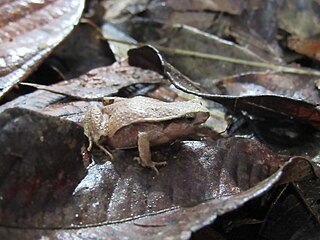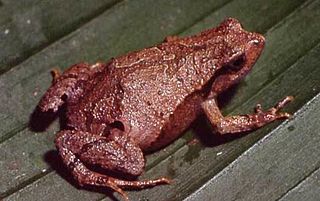
Amazophrynella bokermanni is a species of toad in the family Bufonidae. It is endemic to Brazil and only known from the region of its type locality, the Amazonas state. Its natural habitats are old-growth forests where it occurs in leaf-litter. The eggs are laid on aerial roots over temporary pools where the tadpoles then develop.

Bokermann's casque-headed frog is a species of frog in the family Hylidae. It is endemic to Brazil, known only from Juréia-Itatins Ecological Station, another location 10 km away and Rio Verde. Its natural habitats are subtropical or tropical moist lowland forests.
Dendropsophus bokermanni is a species of frog in the family Hylidae. It is found in Brazil, Colombia, Ecuador, Peru, and possibly Bolivia. Its natural habitats are subtropical or tropical moist lowland forests, swamps, and intermittent freshwater marshes.
Phrynomedusa bokermanni, Bokermann's leaf frog, is a species of frog in the subfamily Phyllomedusinae. It is endemic to Brazil. Its natural habitats are subtropical or tropical moist lowland forests and rivers.
Crossodactylodes bokermanni is a species of frog in the family Leptodactylidae. It is endemic to Espírito Santo state of eastern Brazil. While its range is small, it is locally abundant. It is an arboreal species living in forests near 560 m (1,840 ft) altitude. It is associated with epiphytic bromeliads where its tadpoles develop. It is threatened by habitat loss.
Physalaemus aguirrei is a species of frog in the family Leptodactylidae. It is endemic to eastern Brazil and occurs in the southern Bahia, northern Espírito Santo and northeastern Minas Gerais. The specific name aguirrei honours Alvaro Coutinho Aguirre, a Brazilian zoologist. However, common name Linhares dwarf frog has been proposed for it.
Physalaemus albifrons is a species of frog in the family Leptodactylidae. It is endemic to Brazil. Its natural habitats are subtropical or tropical moist lowland forests, dry savanna, moist savanna, subtropical or tropical dry shrubland, subtropical or tropical moist shrubland, and intermittent freshwater marshes. It is threatened by habitat loss.

Physalaemus caete is a species of frog in the family Leptodactylidae. It is endemic to Brazil. Its natural habitats are subtropical or tropical moist lowland forests and intermittent freshwater marshes. It is threatened by habitat loss.

Physalaemus centralis is a species of frog in the family Leptodactylidae. It is found in Bolivia, Brazil, and Paraguay. Its natural habitats are moist savanna, subtropical or tropical moist shrubland, subtropical or tropical seasonally wet or flooded lowland grassland, freshwater marshes, and intermittent freshwater marshes. It is threatened by habitat loss.

Physalaemus cicada is a species of frog in the family Leptodactylidae. It is endemic to Brazil. Its natural habitats are dry savanna, moist savanna, and intermittent freshwater marshes. It is threatened by habitat loss.

Physalaemus crombiei is a species of frog in the family Leptodactylidae. It is endemic to Brazil. Its natural habitats are subtropical or tropical moist lowland forests and intermittent freshwater marshes. It is threatened by habitat loss.

Physalaemus cuqui is a species of frog in the family Leptodactylidae. It is found in Argentina, Bolivia, and possibly Paraguay. Its natural habitats are subtropical or tropical dry forests, subtropical or tropical dry shrubland, subtropical or tropical moist shrubland, intermittent freshwater marshes, arable land, pastureland, ponds, irrigated land, and canals and ditches.
Physalaemus erythros is a species of frog in the family Leptodactylidae. It is endemic to Brazil. Its natural habitats are subtropical or tropical moist shrubland, subtropical or tropical high-altitude grassland, intermittent freshwater marshes, and rocky areas. It is threatened by habitat loss.

Physalaemus fernandezae is a species of frog in the family Leptodactylidae. It is found in Argentina, Uruguay, and possibly Brazil. Its natural habitats are subtropical or tropical seasonally wet or flooded lowland grassland, intermittent freshwater marshes, and rocky areas. It is threatened by habitat loss.

Physalaemus henselii is a species of frog in the family Leptodactylidae. It is found in Argentina, Brazil, and Uruguay. Its natural habitats are subtropical or tropical seasonally wet or flooded lowland grassland, intermittent freshwater marshes, pastureland, rural gardens, and urban areas. It is threatened by habitat loss.

Physalaemus lisei is a species of frog in the family Leptodactylidae. It is endemic to Brazil. Its natural habitats are subtropical or tropical moist lowland forests, moist savanna, and intermittent freshwater marshes. It is threatened by habitat loss.

Physalaemus moreirae is a species of frog in the family Leptodactylidae. It is endemic to the Serra do Mar in the São Paulo state, Brazil.

Physalaemus nanus is a species of frog in the family Leptodactylidae. It is endemic to Brazil. Its natural habitats are subtropical or tropical moist lowland forests, intermittent freshwater marshes, rural gardens, heavily degraded former forest, irrigated land, seasonally flooded agricultural land, and canals and ditches. It is threatened by habitat loss.
Physalaemus rupestris is a species of frog in the family Leptodactylidae. It is endemic to Brazil. Its natural habitats are subtropical or tropical moist montane forests and intermittent rivers. It is threatened by habitat loss.
Physalaemus soaresi is a species of frog in the family Leptodactylidae. It is endemic to southeastern Brazil where it is only known from three localities in the Rio de Janeiro state, one of them lost to urbanization and habitat degradation.












